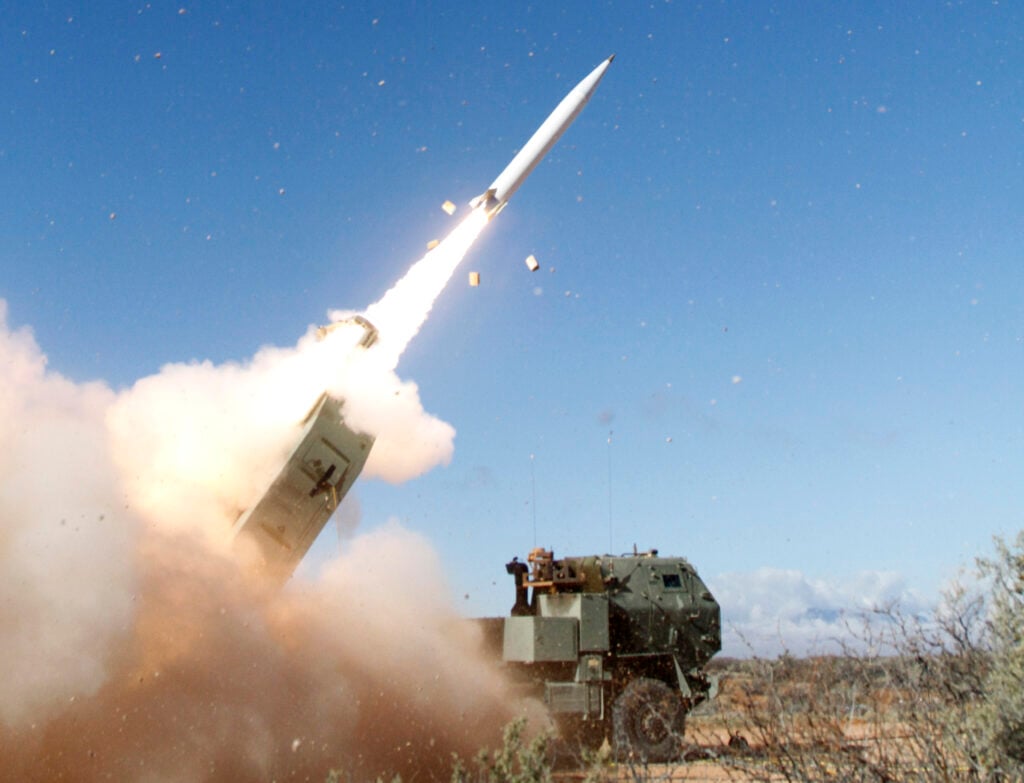
Lockheed’s prototype Precision Strike Missile (PrSM) fires from an Army HIMARS launcher truck in its first flight test, December 2019.
WASHINGTON: The Army has begun testing a new multi-mode seeker — an upgrade for the Precision Strike Missile — even though the missile won’t enter service until 2023,
The upgraded seeker is expected to be part of a major program improvement planned for 2025.
The new multi-mode seeker was tested yesterday for the first time outside the lab. It should allow the upgraded missile, known as “Spiral One,” to hunt a variety of moving targets on land and sea, Army officials told reporters this afternoon.
Yesterday’s test was five years in the making. The Army launched an initiative in 2015 called the Land-Based Anti-Ship Missile (LBASM). The challenge? While the Army’s long-range artillery rockets and missiles can strike fixed coordinates with high accuracy, ships don’t stay still. If the Army was going to help the Navy and Air Force take on the Chinese navy, it needed to upgrade its missiles to strike moving targets.
That required a new sensor – or better yet, multiple sensors — to track the target in different ways and at different distances. After the missile arrives in the approximate area of the target, the “multi-mode seeker” initially listens for radio-frequency emissions from the enemy’s communications and radar. As the missile homes in on the target, the seeker turns on its infrared imaging mode to refine the precise point to strike.
The Army initially sought this multi-mode sensor to hunt Chinese ships in the Pacific. But it quickly realized the ability to track a mobile target by its radio emissions would also be invaluable for tracking down and destroying mobile radars, an essential piece of Russia anti-aircraft defenses in Europe. Using Army land-based missiles to blast a path for airstrikes from all the services is central to the evolving battle concept known as Joint All-Domain Operations, so this mission has become the focus, said the Army’s artillery modernization director, Brig. Gen. John Rafferty.
“Primarily, the PrSM Spiral One approach is against integrated air defense systems,” Rafferty told reporters.
The new multi-mode seeker was mounted under the wing of a small jet yesterday and flown over the Redstone Test Center in Alabama, where it hunted a target in the messy, cluttered terrain of the real world. The Army’s now crunching the data gathered to see if the seeker’s algorithms need refinement, said the Aviation & Missile Center’s Mike Turner, the primary science & technology advisor to Rafferty’s artillery modernization team.
That test was just the beginning, Turner said, with the seeker operating at “about half its capability.” This fall, he said, the jet will take it up for another test flight, but this time will function at full power against a more realistic target, at the much larger White Sands Missile Range.
“A few months after that,” Turner continued, the seeker will be installed on a “surrogate missile” for three further flight tests. If all goes as planned, the seeker will then be installed on actual PrSM missiles for final testing in 2025.
That upgrade is just one of many planned for PrSM, Rafferty emphasized. The base Precision Strike Missile entering service in 2023 will offer dramatically greater range – more than 500 km (313 miles) — than the Reagan-era ATACMS in current use. Spiral One in 2025 will add the ability to track moving targets on land and sea. Spiral Two, with no set date as yet, will focus on “enhanced lethality,” probably by developing an alternative warhead that can eject submunitions to strike multiple targets, like a formation of armored vehicles; that will require further seeker upgrades, Rafferty noted. Spiral Three will increase the missile’s range to 700-800 kilometers (438 to 500 miles). Despite the names, it’s possible that Spiral Three may actually enter service before Spiral Two, Rafferty said: The service will see how both the technology and the threat evolve.
In the near term, the challenge is just getting all the engineering and testing done without exposing the Army and industry workforce to COVID-19. That required some work to get done while wearing masks and other protective equipment, Rafferty said, but it got done. The dedication to staying on schedule while still protecting the people was “very inspiring,” Rafferty said.
“We don’t have time to wait,” he said. “There’s a pacing threat and the Army’s counting on us to deliver.”
Air Force picks Anduril, General Atomics for next round of CCA work
The two vendors emerged successful from an original pool of five and are expected to carry their drone designs through a prototyping phase that will build and test aircraft.


























